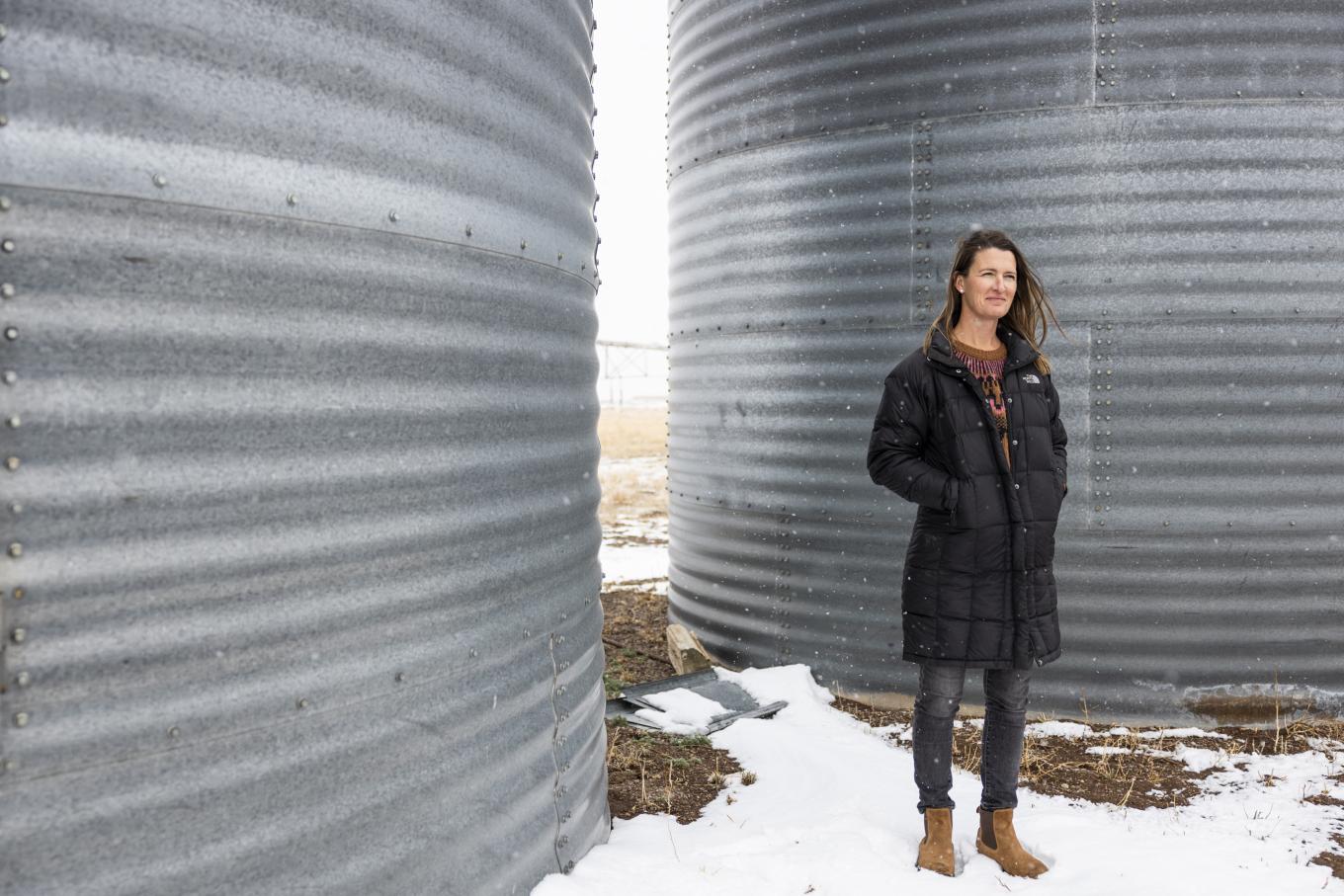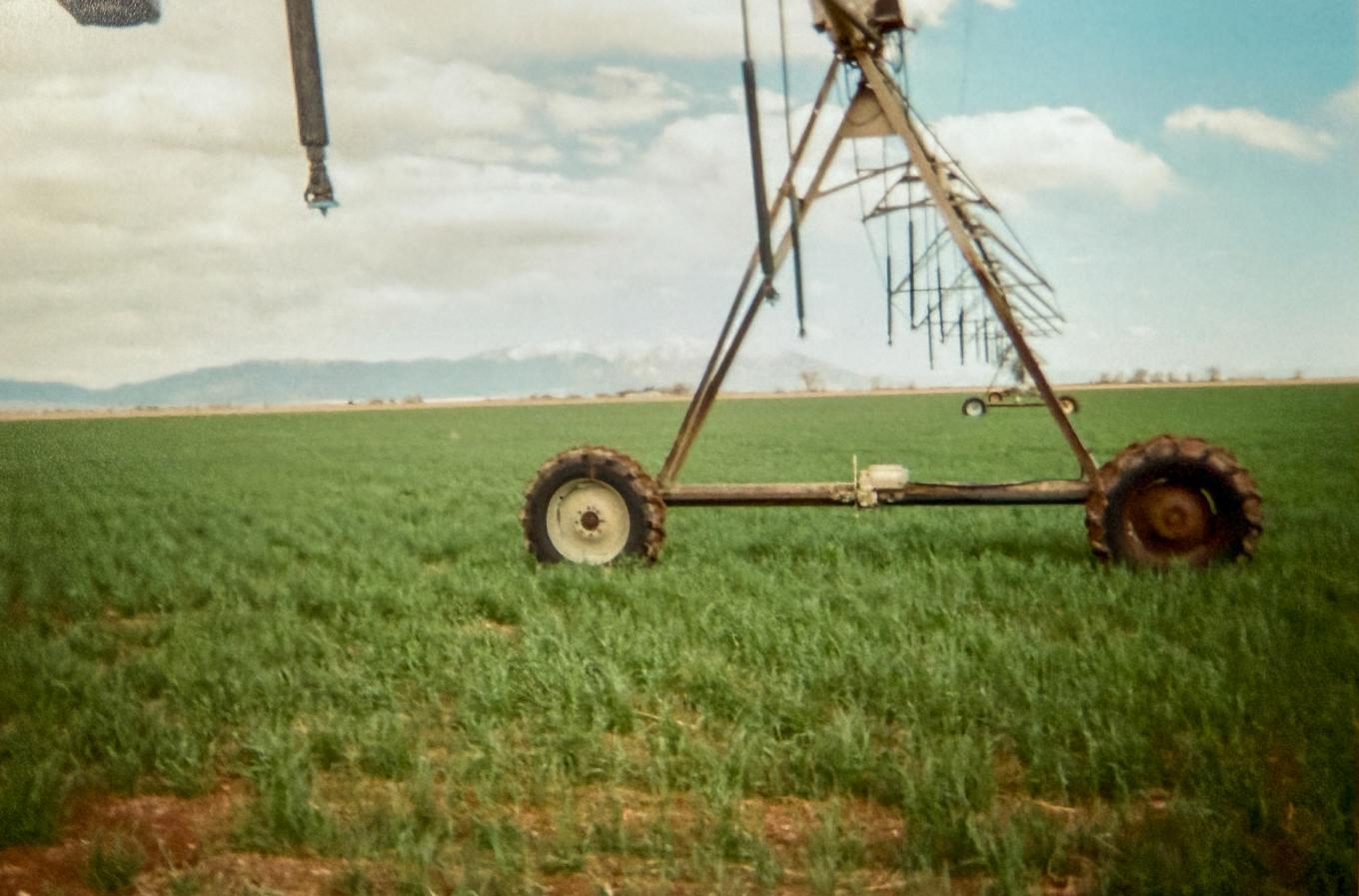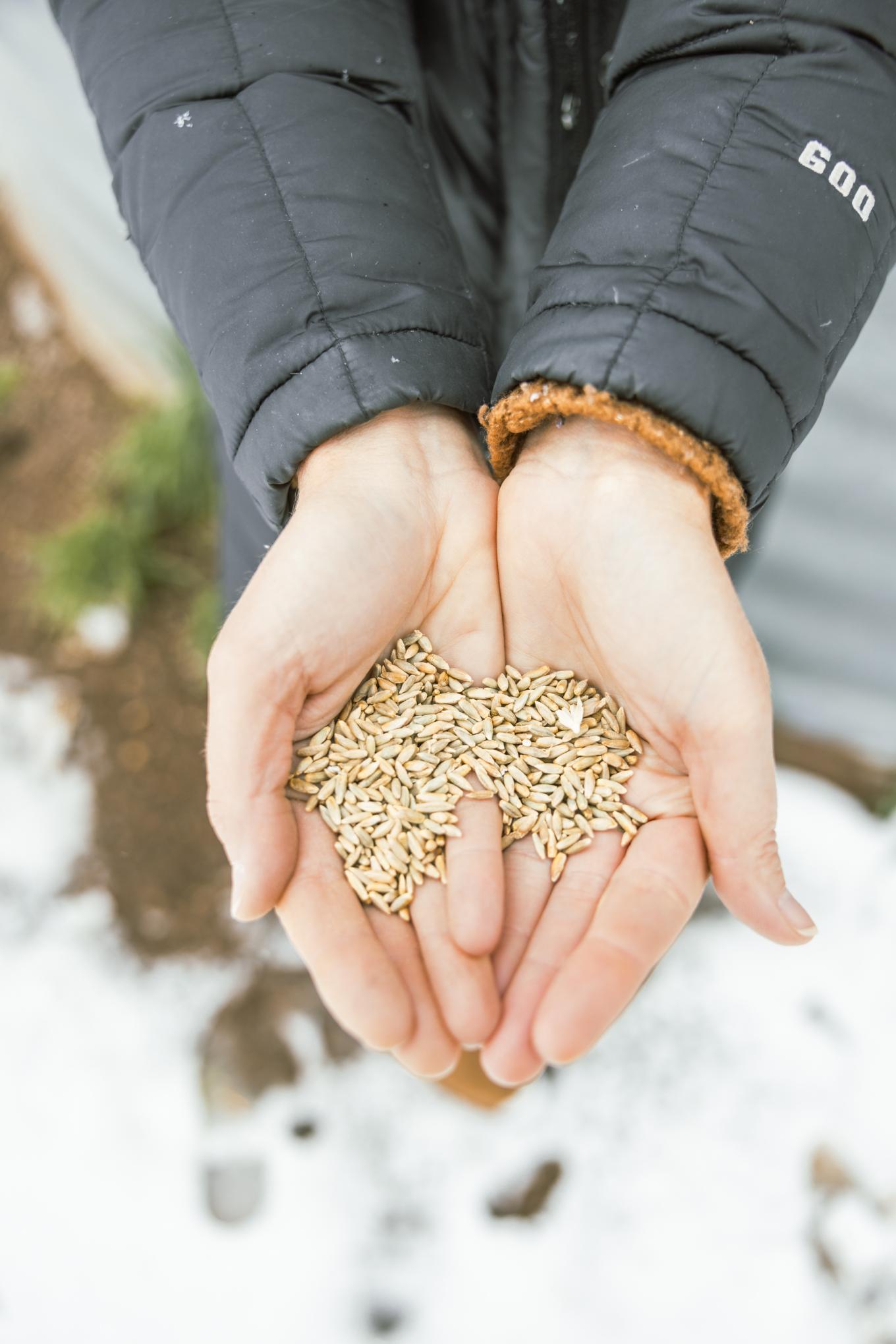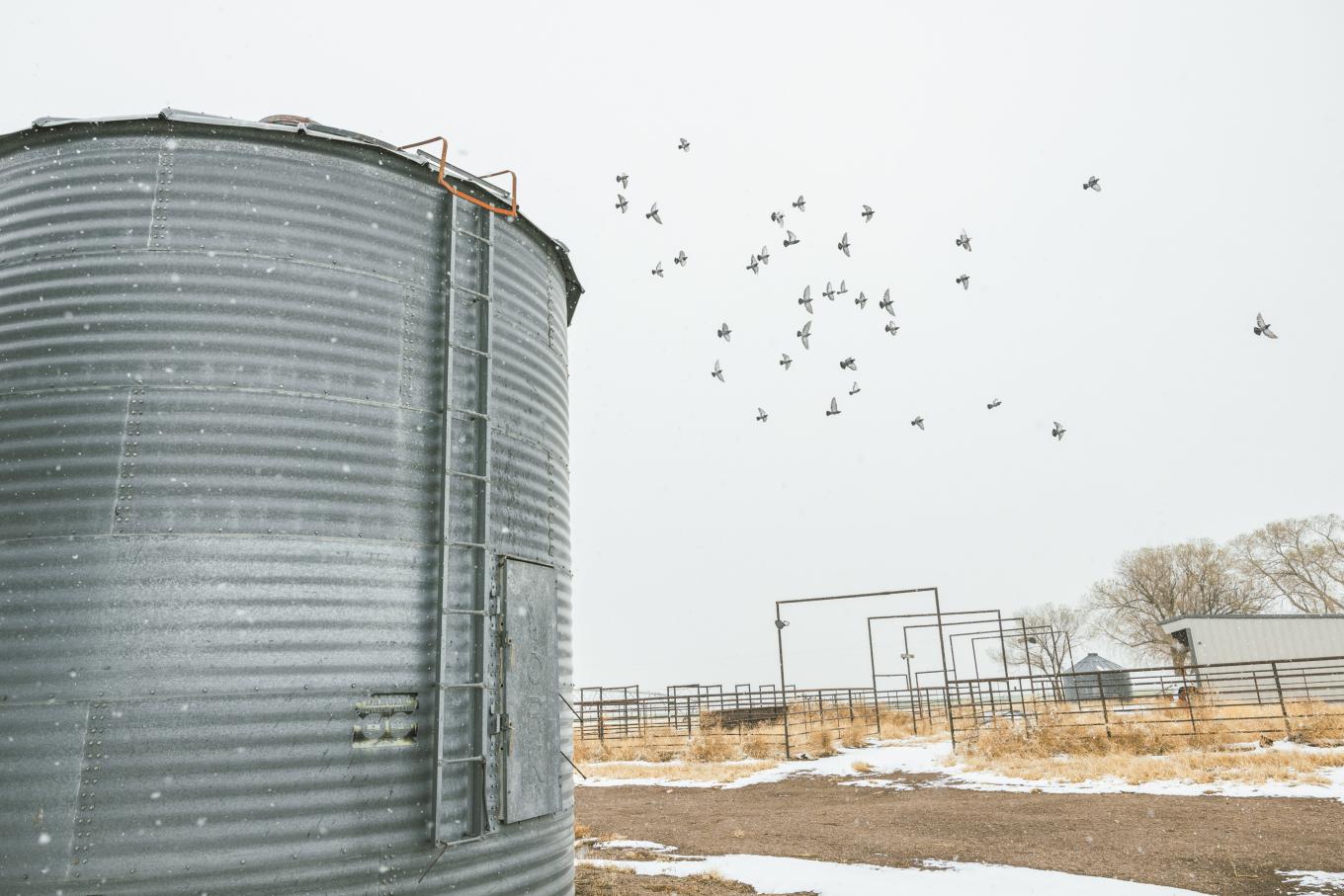
The Mad Agriculture Journal
Holding Ground
Published on
August 12, 2025
Written by
Emily Payne
Photos by
Nina Riggio
Opal Jones
Rye, Dust, and the Future of Farming in the San Luis Valley
April is the windiest month in the San Luis Valley, Colorado. This broad, flat, and dry region is bordered by three mountain ranges. Residents often drive through dust blowing off the agricultural fields that line county highways. In recent years, dust storms fueled by historic high winds have created zero-visibility conditions. It is not uncommon to spend an hour waiting out a sudden dust storm while running errands in town.
But one day this spring, Sarah Jones was struck by a different view.
“The left side of the road is dirt, sand, no soil coverage, and you cannot see a few feet in front of you,” says Jones. “And then you look to the right, with a couple of inches of rye crop, and you can see significantly farther.”

photo: Nina Riggio
Jones runs a fourth-generation farm in the Valley with her husband, Michael, and three daughters. She and Heather Dutton, District Manager of the San Luis Valley Water Conservancy District, co-founded the Rye Resurgence Project. It is a farmer-led initiative that aims to combat dust storms, protect soil health, and create economic opportunities for local farmers—all by encouraging farmers to plant more rye.
“Just a couple of inches of green could have a huge impact and make a difference on our road safety, our morale, our air quality, our topsoil,” says Jones. “Under the soil, those roots, which are not seen, have so much more meaning and impact than the human eye can even realize.”
Jones and Dutton argue that planting rye could not only help keep soil on the ground but also reduce the Valley’s agricultural water use, increase soil health and fertility, boost morale across the Valley, and keep farmers farming. In other words, this crop could be key to revitalizing the Valley’s agricultural community.

photo: Opal Jones
A Rural Economy in Crisis
The San Luis Valley is a high-altitude desert in one of the driest regions of Colorado, and it is only getting drier. Historic drought and over-appropriation of water resources have stressed aquifers throughout the state. The effect on the Valley is all too clear to those living there: dust storms are becoming more common.
Dust storms are a clear public health concern. Jones remembers her aunt driving down to visit a few years ago when she suddenly had to pull off Highway 17. There was a 15-car pile-up because cars couldn’t see more than a few feet in front of them in the orange-brown air. Researchers are increasingly concerned with air quality; San Luis Valley children have higher asthma rates than the rest of the nation.
Dust storms also threaten the backbone of the region’s economy: agriculture. The San Luis Valley is the second-largest fresh potato-producing region in the United States. However, with drought and increasing water shortages, farmers are increasingly leaving fields bare or selling their water rights and drying up entire farms. More fields left without living roots means more dust blown during a storm, and valuable topsoil lost from farmers’ fields.
“There is a true risk of agriculture reducing irrigated acres and going out of business,” says Colorado Commissioner of Agriculture Kate Greenberg. “It can truly impact the economy, the culture, the community, and what the Valley looks like. It’s a real threat.”

photo: Nina Riggio
Jones’s family has grown rye at Jones Farms Organics since the 1980s, long before Sarah and Michael took over the farm in 2017. Jones explains that potato harvest disrupts the soil, so they plant rye as a cover crop immediately after fall harvest to improve soil structure, suppress weeds, and add nutrients to the soil. By spring, the rye roots are strong enough to protect the soil and reduce erosion in the face of high winds. Importantly, rye requires only about 12 inches of water to grow, compared to 18-22 inches for barley or 24-26 inches for alfalfa. Farmers can essentially plant it and forget it.
“Rye is one of the only things that can grow down here in the Valley consistently. It’s very hardy, it can survive our harsh winters, which can be down to negative 30,” says Jones. “Finding things that can survive that is hard.”
The Jones family started growing heirloom wheat varieties for new customers across the Front Range, and Jones quickly realized that these customers were also excited about locally sourced rye. What was once a cover crop soon became a cash crop, too. Jones Farms Organics was selling 100% of the rye it grew to chefs, distillers, and brewers who were commending its unique terroir.
“I’m thinking if little old me, who doesn’t have a background in agriculture or sales, can sell 100% of what we’re growing…the possibilities are endless for all of these farmers to be able to connect directly with the thousands and thousands of buyers in the state,” says Jones.
In 2023, Jones received a text from Sangre de Cristo Schools that it was unsafe to pick up her children during a particularly harsh dust storm. She remembers sitting at her kitchen table, reading the text, and deciding it was time for action.
“I was sad, frustrated, disheartened for a few minutes, but I’m not very good at just wallowing in my frustration,” says Jones.
She picked up the phone and started calling every neighbor she could reach. Her number one question was, Why aren’t you planting rye?

photo: Opal Jones
Greener Fields
Jones heard a consistent storyline from her neighbors: they had planted rye in the past but stopped due to a lack of market and low prices.
“If I’m going to plant it, water it, use diesel on it, and spend time and energy, I’d also love to get paid for it, right?” Jones remembers hearing. “With the regenerative movement or encouraging farmers to farm differently…cover crops are great, but why would we expect someone to do something that they wouldn’t get paid for? Being able to grow something and then also get paid in actual dollar amounts, not carbon credits? What a novel idea.”
Jones wondered, could there be a price that would make it worth it for farmers in the Valley to plant rye and help protect against dust storms? The answer surprised her.
“For 5 to 10 cents more per pound, we can literally prevent the Dust Bowl overnight, by helping tell the story of rye…The versatility of rye, the importance of rye for our soil, our health, our climate, the aquifer,” says Jones. “And help these farmers get a more fair price.”
Jones and Dutton got to work talking with growers and connecting them to chefs, bakers, distillers, and brewers throughout the state. They aimed for farmers to plant 1,200 more acres of rye, but they quickly surpassed that goal. In 2024, farmers planted 4,000 more acres of rye than the previous year. Today, the project has over10 buyers including prominent businesses in the Front Range like Laws Whiskey House, The Family Jones distillery, Moxie Bread Company, Joy Hill, and Dry Storage.
The fruits of their labor are clear. Fields in the Valley are typically brown and barren after a long, cold winter. But this spring, Jones and Dutton noticed significantly more green in the landscape. Rye was coming in. And the community was reaping its benefits.

photo: Nina Riggio
“When you see the wind come through the Valley, which has some of the strongest winds in the state, and you’ve got one piece of ground that’s staying intact, it does provide a morale boost,” says Commissioner Greenberg. “It makes a difference when you’re facing winds like they do and the evapotranspiration that comes with high winds and high temps…to be keeping that soil intact and see it through this project.”
On a particularly windy day this spring, Dutton spent an hour driving laps around the community, observing the changes. She passed a barren field, blowing so much dirt that the road wasn’t visible. Then she passed two fields of rye. The first, bordering the barren field, was getting pelted with dirt. But by the time Dutton made it to the farther field, “the wind was howling, but the air was totally clear. You could see the dirt off in the distance.”
But this seemingly simple concept—plant rye, sell rye, pay farmers—hasn’t been as easy as Jones and Dutton anticipated. Growing more rye is only the first step in building a resilient local grain economy that sustains the region’s agriculture.
The Missing Middle
Growing rye is easy for many farmers in the San Luis Valley, who have been growing small grains for generations and already have the necessary tractors and infrastructure. The problem is creating a local grain value chain that can absorb the increased demand.
“It’s not just about getting more growers to grow rye,” says Dutton. “It’s making sure that we’re selling rye at a price that is fair to farmers and not just trying to undercut them so that the middleman can make more profit. We have to have that profit come down to these farmers if they’re going to truly be able to stay on this land.”
Local millers and malters, for example, can produce value-added products to get more customers eating rye while keeping more economic value in the Valley and paying farmers a fair price. Colorado Malting Company—one of the first craft malt houses in the U.S., based in the Valley—was recently awarded a grant from the Colorado Water Conservation Board to expand its facilities to accommodate demand for the local, high-alpine rye. This will provide critical middle-market expansion for the Rye Resurgence Project.
But the key to building the entire market, from farmers growing rye to millers, bakers, grocers, and consumers participating in the value chain, is more education. Jones calls it “rye rehabilitation.”
“Everyone knows rye,” says Jones. “Some people dislike it because, of course, they think it tastes like caraway seeds…my number-one sales point is rye does not taste like caraway seeds.”

photo: Nina Riggio
Rye has a nutty, earthy, or spicy flavor, which acclaimed regional chefs and distillers increasingly covet for everything from beer to pizza dough. But the grain is typically associated with bread, and rye bread is almost always made with caraway seeds, at least in the United States. Some say the seeds help with digestion, while many others steer clear of rye altogether because of the distinctive flavor of caraway. Jones wants to change that.
This year, she asked a room full of grain farmers, millers, and bakers at an industry event to raise their hands if they thought—or previously thought—rye tasted like caraway seeds. Despite making a living off grains, almost every hand went up. One customer told Jones that she had been having trouble selling rye flour in her store, but they were flying off the shelves when it was baked into cookies. Rye has a branding problem.
“We literally need to serve stuff to people on a platter,” says Jones.
Jones and Dutton are now focusing on connecting with more consumer bakers. They share recipes for rye chocolate chip cookies, banana rye muffins, and carrot cake rye muffins. According to Jones, swapping half of a typical recipe’s white flour with rye flour will produce a more nutritious and flavorful baked good. Educating the public on the importance of local grain sourcing is key to long-term success for the Rye Resurgence Project—but the revolution must be delicious.
Common Ground
Part of the Rye Resurgence Project’s success so far can be attributed to the San Luis Valley’s unique community, which has historically relied on local collaborations due to its isolated nature. The project was built on these connections. And Jones says it helps that rye is an easy tool to find common ground.
“Rye is an amazing option for any farmer, whether they’re conventional, organic, or ROC-certified. Anyone can plant it, and it has those amazing benefits,” says Jones. “You can really neglect it and not put a ton of additional inputs in it, and it can still produce a crop that you can eat or drink.”
photo: Opal Jones
Communities across the United States can learn from Jones and Dutton’s work, says Commissioner Greenberg. Agriculture industry efforts to adapt to a changing climate must start with not only farmers but also market development.
“We’ve got massive environmental problems that we’re facing. Climate change is chief among them, and all the related impacts. But if we don’t expand our market access and market capacity and value the type of agriculture that is responding to these changing conditions, then we’re reaching a dead end,” says Commissioner Greenberg. “You have got to have market development in play. That’s a really key message for efforts around the country, not just Colorado, that are focused on this kind of work.”
Low-water-use crops only make an impact when there are markets behind them. And of course, this work takes time and money. Dutton says that the Rye Resurgence Project would simply be a good idea without support from the San Luis Valley Conservancy District and the Colorado Water Conservation Board to build those markets.
“As simple as it sounds, to save water by growing markets…It makes so much sense, but it’s not how people across the west have always been approaching saving water,” says Dutton.
“Farmers, ranchers, water, we’re all part of the same community. It’s in all of our best interests to keep farmers farming.”
